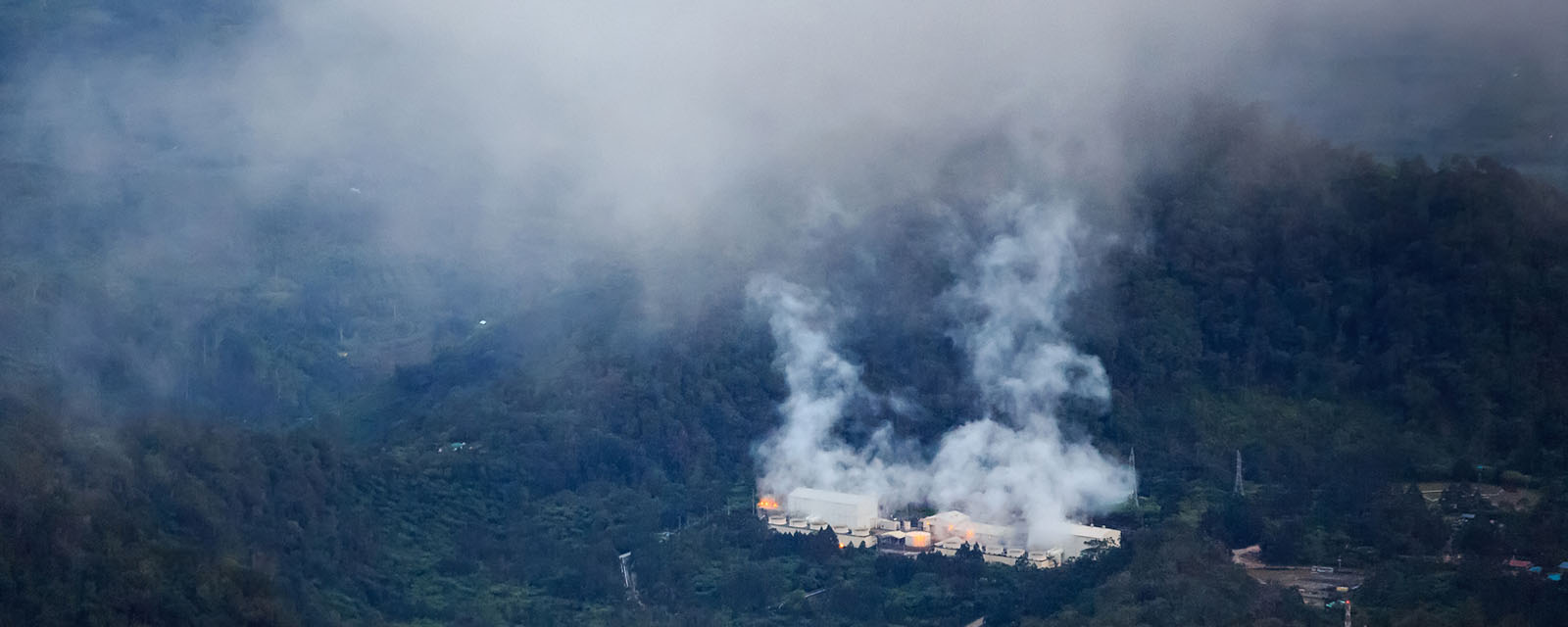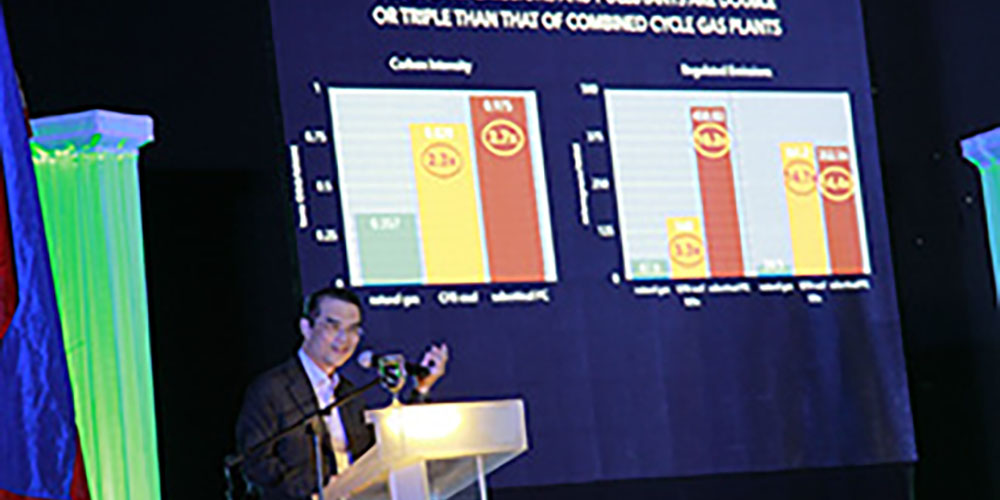There’s a revolution happening in the world today with many powerful vectors converging to change the energy industry as we know it. I’m quite excited by it because if we’re able to seize them and ride the wave, we have a golden opportunity to leapfrog and build a power industry that’s truly for the 21st century. That power industry must not only address inclusive economic development but exponential technological advances and climate change as well.
Let me start by saying that last May 2016, we made the categorical announcement at our Annual Shareholders Meeting that our group of companies would not invest, build, or develop any coal-fired power plants. Last year (2017), we also broke the traditional mold of our corporate Annual Report front pages to drive the point home even more.
We were the only large energy company in the Philippines to declare unconditionally that we would not do coal-fired power. It wasn’t always that way; we were actively bidding for power plants, which included coal, during the Philippine government’s privatization program. Being among the three largest power companies in the country, we definitely had the organizational capability and resources to develop coal-fired plants. We bought a number of sites intended for such plants in Southern Philippines and engaged a number of coal experts for our Business Development teams.
Operating in a deregulated and privatized power market in the Philippines means staying competitive and having the cheapest generation sources in order to keep winning customers. Coal, given its abundance in the world, was traditionally among the cheapest fuels for power generation (that has changed in the last year or so; more on that later). We’ve always been staunch believers in a decarbonizing pathway but I’ll be the first to admit that we believed the world still had more time to get its act in order.
However, that view changed immensely in November 2013, when our largest geothermal plant in Leyte, Southern Philippines, was directly hit by one of the most powerful typhoons on historical record to ever to hit the planet.
Personally fearing for the lives and safety of all 743 of our employees and seeing them knocked off their feet overnight; seeing hard-nosed mayors literally crying and desperate for food and water; witnessing the enormous suffering of communities who lost loved ones and whatever few possessions they had ---- seeing all these first hand, as well as the scale of rescue, relief, and rebuilding efforts that came after, has had an enormous impact on how we’ve moved forward as a company. It’s not hard to imagine why the Global Climate Risk Index always ranks the Philippines among the top 5 most vulnerable and the #1 country in the world affected by climate-related disasters over the last 20 years. This was the rude wake up call that as an energy company, it can no longer be “business as usual”.
Recently, we’ve been overwhelmed by so much evidence telling us that we have much less time to act than originally believed. Global warming is here, wreaking havoc on the Earth’s water cycles and creating weather extremes like we’ve never seen before and it is accelerating faster than previously imagined because of all the feedback loops being unleashed.
- In a recent study published in Nature Geoscience, it showed that the proportion of Category 4 and 5 storms in the Asia-Pacific region have doubled or even tripled over the last 37 years. The destructive power of these typhoons has also increased by more than 50% over this same period.
- Kerry Emanuel, a hurricane expert at MIT also showed in 2005 that Atlantic hurricanes are about 60% more powerful than they were in the 1970s. Storms lasted longer and their top wind speeds had increased by 25%.
- NASA’s Goddard Space Flight Center also concluded in 2012 that rainfall totals from tropical cyclones in the North Atlantic have risen at a rate of 24% per decade since 1988.
- NOAA scientists looking at 120 years of data also found that the number of extreme snowstorms between 1961 and 2010 has more than doubled relative to the previous six-decade period 1900-1960.
- NASA’s Earth Observatory also cites studies of satellite altimeter data over the last two decades that hurricanes intensify much faster than they did 25 years ago. They attain Category 3 wind speeds nine hours faster today.
- Ground-based records of weather stations in the US also show 76% of those stations witnessing a substantial increase in extreme precipitation since 1948. One analysis found that extreme downpours are happening 30% more often today.
- In fact, when Typhoon Yolanda hit us in 2013, the total precipitation amount was 615 mm. In Dec 13-16 of last year when Typhoon Urduja hit, she lingered for 4 days and dumped a total of 1,400 mm of rain during that short period!
- The years 2014-2015-2016 were in quick succession the hottest years ever; 2017 now ranks as the third hottest on historical record too! 2017 also marks the 41st consecutive year (since 1977) with global land and ocean temperatures at least nominally above the 20th century average. All 17 years of the 21st century rank among the 18 warmest on record; the six warmest years have all occurred since 2010. Sixteen consecutive warmest months on historical record were logged from May 2015 to August 2016.
- last April 26, 2017, another record was broken when the CO2 level in the atmosphere breached the 412 ppm threshold for the very first time in recorded history. This signaled that we’ve now used up 90% of that carbon concentration budget as most scientists agree we should not go beyond 450 ppm.
The world is now 1.1°C warmer than it was in pre-industrial times, which means we only have 0.9°C to go before we exceed the Paris COP 21 commitment of restraining the average global temperature rise to less than 2°C. Beyond this threshold, scientists acknowledge that the world becomes extremely dangerous for all of us. Many experts including the UNEP are saying we have two to three years left before the door closes to limiting temperature rise to 1.5 degrees C, many are in fact saying COP 21 only gets us to a 3 degrees Celsius world.
Many experts believe we are now living in an era where we could see more than half the species on earth wiped out before the end of the century. American journalist Elizabeth Kolbert expounds on this in her Pulitzer Prize-winning book, The Sixth Extinction: An Unnatural History. The last mass extinction occurred 65 million years ago, but which happened over thousands of years. Today we could see it happening in just over a few decades! We need to be off carbon in 30 years or less if we are to make it as a planet.
The global response is shifting fast but needs to move even faster to avoid catastrophe. As the IPCC highlights, inaction today has enormous consequences on the scale of the reaction required tomorrow. With every day of hesitation, we just make it increasingly tougher and less feasible for our children’s generation to correct.
Mark Carney, the Governor of the Bank of England and Chairman of the Financial Stability Board, in his famous address to a gathering of the world’s top insurers at Lloyd’s of London in September 2015 warns of massive financial instability that could result from Climate Change. He states that since the 1980s the number of weatherrelated loss events has tripled, and inflation-adjusted insurance losses from these events has gone from US$ 10 Billion annually in the 1980s to over US$ 50 Billion annually over the last decade. He underscores the IPCC estimate that henceforth only 1/5th or 1/3rd of the world’s proven reserves of Oil, Gas and Coal can be used if we want to keep the world below the 2 degree target. This is what some are calling the Unburnable Carbon conundrum ---Trillions of dollars of reserves on the books of Oil, Gas and Coal companies as well as producing countries which in reality could be written off as worthless. This could mean impairing assets of many companies representing one-third of all equity and fixed income assets all over the world! (1/3 of all the stocks and bonds around the world!)
Carney is now a staunch advocate, through the G-20 backed Task Force for Climate-related Financial Disclosures (TCFD), of greater transparency and reporting of the risks from climate change faced by banks, insurance companies, and businesses in general. Greater transparency of the risks hopefully promotes an orderly adjustment to the changes world markets need to make. This would help prevent another financial meltdown with a magnitude many times the size of the 2008 subprime crisis.
As an energy company in the Philippines, we face quite a number of challenges.
Price competition is intense and retail competition and open access is underway. Low price is still the main driver of electricity consumers. This has driven down profit margins of all power producers. But we’re driving down costs in our geothermal business, both the old fashioned way and through the use of new technology.
Yet another challenge is the short-term perspective of a government ambivalent about climate change issues. Despite our countrymen’s vulnerability to the effects of global warming, only token importance is given to such concerns in national public policy. Priority is power adequacy and cheap electricity prices. The recent Coal Tax was a step in the right direction but will only amount to as little as one to three centavos per kwh in tariffs to coal-fired power plants. In other countries like India the coal tax is six centavos per kwh, in South Korea it reaches twenty five centavos per kwh..
Coal-fired power plants, being the easiest to develop and its fuel supply the simplest to procure, every competitor and new entrant is seeking to build more coal-fired power plants in a vicious race to the bottom. Adding to these pressures is the fact that majority of banks continue to finance coal production and coal-fired power generation. In fact, major banks financed the top 120 coal plant developers by more than US$ 600 Billion over the last four years. They’ve been slow to embrace COP 21 despite verbal pronouncements and still have quite a way to go. (If they transitioned away from coal there would be a shift toward lower carbon alternatives, renewables and even energy efficiency.)
For the last four years, Boston Common Asset Mgmt – a sustainable and responsible portfolio management advisory firm for investors -- supported by 100+ institutional investors with USD2.0 trillion in assets under management, have been engaging with 59 of the world’s largest banks. In their latest report, they conclude that although there is notable progress in a number of areas like knowledge-sharing on climate risks and solutions as well as some exclusion policies for carbon-intensive practices...”we have yet to see widespread adoption of comprehensive climate strategies covering all business functions and intentional commitments to reduce exposure to carbon-intensive sectors backed by explicit targets and timelines. We found limited evidence of banks taking systematic approaches to promoting lowcarbon products and services. Furthermore, most of the banks engaged do not appear to be taking a progressive approach to public climate policy, This last component is an obstacle to creating necessary incentives and infrastructure required by the market in order to align with the Paris Agreement commitment.”
You might wonder what keeps us committed to this green road despite all the obstacles?
There are more and more companies that are conscious about greening their footprints and supply chains. This has a lot to do with the millennial consumer coming of age. In the Philippines we’ve been seeing some electricity customers specifically coming to us because they want to green their supply chains with renewable power. Then there is the RE 100, 125 of the world’s largest companies pledging their individual glide paths toward using 100% renewable energy in their supply chains.
There is also recognition from various groups: last October 2017, in the Asia CEO Awards, First Gen was awarded the Green Company of the Year; our parent company, First Philippine Holdings, was also honored last December with the 2017 PSE Bell Award for Best Sustainability Program; back in 2011, our geothermal company EDC was bestowed the IFC Client Leadership Award for its commitment to environmental stewardship, social sustainability and good corporate governance. Just last week, EDC was included among the 2018 Q1 Carbon Clean 200 – a global list of publicly traded companies above a billion dollars market cap that are “leading the way with solutions for the transition to a clean energy future” EDC was the only Filipino company on the list. And of course, the appreciation we get from kindred souls like all of you and summits like these, which remind us that we are not alone in what sometimes feels like a lonely battle.
Another reason we’re so committed to our Green platform is they happen to be very competitive in the Philippine market. The Philippines is primarily a Services driven economy. Retail Competition and Open Access that’s underway and progressing will disaggregate that demand. Our portfolio that blends flexible natural gas fired plants and geothermal (which is the only competitive 24/7 RE technology today) is a better combination for serving this type of demand called mid-merit. Having said that, in fact natural gas and geothermal, with just 1/3 and 1/10 the carbon emissions respectively of even the most advanced coal plants, are capable of beating the latter’s prices at baseload today.
Another reason for optimism about clean energy is that the Forces of Technology moving very fast. Solar, wind, and battery storage have experienced exponential cost reductions over the last few years. Never in my 20 years in the power industry have I seen anything move so fast. The last two years also saw a series of record lowprices for PV Solar in high irradiation areas like Dubai (3 US Cents/kwh), the Atacama desert in Chile (2.9 US cents/kwh), and Abu Dhabi (2.42 US cents/kwh). Solar PV solutions even coming in more aesthetic and friendly forms like Tesla’s solar roof tiles.
As more renewables come onto the grid, the shape of demand changes (yearly and daily, peaks shaved, electricity demand growth curtailed). The “Duck Curve” is a phenomenon being experienced by electricity utilities as more renewables penetrate their franchise areas. Between 2011 and 2016 in California, there was a progression of more renewable energy being added on to the grid and on rooftops of individual homes and businesses. If you refer to the Duck Curve, you’ll notice how the belly of the duck is getting bigger over the years not because people are using less electricity in their homes but because they’re using less from the grid during daylight hours. But you’ll notice too how rapid a ramp up in power supply is needed from the utility as the sun sets. This is a phenomenon that utilities must learn to deal with as more intermittent renewable energy use gains momentum. However, when storage batteries get cheaper and more ubiquitous, this dynamic will alter yet again and you will see some households defecting partially or even totally from the electricity grid. The momentum for more Solar PV’s installed and later on storage batteries will be unstoppable as the economics gets better in the coming years. But the power grid will become more challenging to manage in the interim.
However, keeping the lights on in the transition means using many tools that help the electricity industry manage the variability and intermittency that are inherent in renewable energy (the sun is not always shining, or you get cloud cover, or the wind is not always blowing). Tools such as flex plants, HVDC transmission networks that expand the geographic coverage of wind and solar to smoothen out variability of sun and wind over wider areas, demand response programs (e.g., interruptible load , utility controlled water heaters and appliances), ice storage HVAC, pump hydro, compressed air, battery storage, and flywheel storage. I will not discuss these in detail but just keep in mind that when someone tells you that Renewable Energy is intermittent and makes power grids unstable know that there are many technically and economically feasible ways to handle these issues, and progressive grids are already incorporating them into their day to day operations.
Coal-fired power plants can’t keep up with that kind of variability and may likely end up as underutilized or stranded assets in ten years or less given the rapid pace of renewables. In countries like Australia, Germany, and some US states like California with even modest Renewable Energy penetration they are already experiencing Coal and even Gas plants being utilized less or being idled.
Just a year ago, policy makers around the world, including the Philippines, were arguing that despite Global Warming concerns, Coal was needed for economic development. What a difference a year can make. Coal is no longer cheap. It doesn’t have the flexibility needed for the inevitable penetration of RE sources into our lives. Even advanced coal plants have carbon emissions and pollutants double or triple that of the standard combine cycle gas turbines.
Natural Gas fired power plants, on the other hand, are seen as indispensable technology for keeping the lights on in the transition to the all-renewable future we’re heading towards. There are 3,200 MW of existing Natural Gas plants using Malampaya gas today. The same plants can be used during the transition (15 years? Or 10 years?) until they’ve served their purpose and we’ve finally transitioned to a decarbonized world. There is not much need for many new plants. We can utilize them only as needed, gradually receding in use through the transition till they’re retired. They have the needed ramp –up speed, flexibility, and only a fraction of the emissions of Coal plants.
Gas and Oil prices are low and range bound. Those prices are likely to stay low because of the structural shifts in the oil markets caused by plentiful supplies in the US and globally and a foreseeable decline in demand from the transport sector (which accounts for 50% of current demand) in the near future. Road and even the Marine Transport sector are rapidly moving towards electric power. Electric Vehicles are projected to displace as much as 2 Mbd by 2025. By 2050 they could displace as much as 25 Mbd. (Note: The collapse in oil prices to US$ 30/bbl in 2014/2015 was caused by only a 2 mbd shift in the supply demand balance brought about by the US Shale oil producers.)
In closing let me say that it would be nice to believe that that this revolution will occur peacefully, and in due course. However that belief blissfully ignores the huge investments at stake in this great and astonishing energy transition that’s underway. More astute observers believe that Coal and other high carbon-emitting assets, especially new ones, as the poet Dylan Thomas would say, will not “go gently into that good night.” What’s more likely, to paraphrase him liberally, is that they will continue to, “rage, rage against the dying of the light”. But I must say that your vigilance, your actions, and your choices as advocates and consumers will be indispensable in the pivotal years ahead. The direct engagement of civil society and environmental groups’ in energy issues is the only assurance we have that the country does not blindly lock itself into the old electricity paradigm. Instead, we must seize this opportunity to build a new one that leapfrogs us for the demands of the coming century.

















